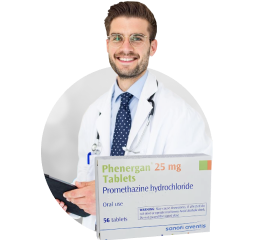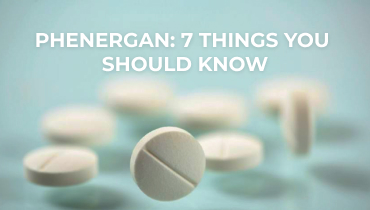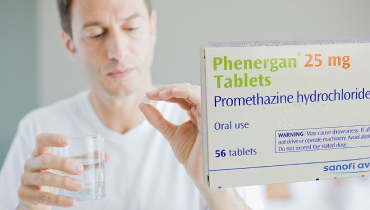1. How it works
- Phenergan is the brand name (trade) name of promethazine, which can be used to treat a variety of conditions such as allergies, rhinitis, nausea or vomiting, or insomnia.
- Promethazine (Phenergan) acts on histamine-1 (H1) receptors. H1 receptors are present in the bronchial tubes and in the circulatory system. Histamine attachment to these receptors causes bronchial constriction and increased vascular permeability, resulting in plasma leakage. H1 receptors are also present on T cells, B cells, monocytes, and lymphocytes, and stimulation of these receptors causes proinflammatory effects. Phenergan can also be used to treat nausea and seasickness and can have weak effects on other receptors such as dopamine, although it is estimated to be 1/10th of chlorpromazine.
- Promethazine (Phenergan) belongs to a class of drugs known as phenothiazines.

2. Benefits
- Can be used to treat rhinitis (vasomotor and allergic), conjunctivitis caused by allergies or food, mild urticaria (itchy rash) and other allergic reactions. May also be used with adrenaline for more severe allergic reactions (such as anaphylaxis) after the acute event has been controlled.
- Can be used to prevent or treat motion sickness.
- Can be used as a sedative before or after surgery or in women during childbirth. Relieves anxiety and induces a light sleep from which the person can be easily awakened.
- Can be used to prevent and control nausea associated with surgery or anesthesia.
- Available as tablets for oral administration, syrup for oral administration, powder for preparation of a mixture, in the form of injections and as suppositories (for rectal use).
- It is available as 12.5 mg, 25 mg, and 50 mg tablets and rectal suppositories.
- Phenergan is available in a generic form called promethazine.
3. Disadvantages
If you are between the ages of 18 and 60, are not taking any other medicines, or have no other medical conditions, side effects you are likely to experience include:
- Drowsiness, which can affect a person’s ability to drive or operate machinery. Avoid drinking alcohol and doing hazardous work.
- Heart rhythm disturbances, dry mouth, confusion, tinnitus (ringing in the ears), double vision, restlessness, and dizziness have also been reported.
- Rarely, respiratory depression (unusually slow and shallow breathing); children are at greater risk. Avoid use in children under 2 years of age because fatalities have been reported.
- Rarely can cause unusual symptoms such as oculogyric crisis (prolonged upward deviation of the eyes), torticollis (the head involuntarily turns to one side), and sticking out the tongue. Confusion, tinnitus (tinnitus), hyperexcitability, and seizures have also been reported.
- Occasionally, paradoxical reactions (the opposite of what is expected) may occur. Symptoms include agitation and nightmares. Children and the elderly may be more susceptible to these effects.
- May not be suitable for some people, including those with pre-existing breathing difficulties (such as asthma, COPD, sleep apnea), a history of seizures, sulfite allergies, glaucoma, urinary tract problems, weakened immune system, bone marrow suppression or with heart or liver disease. Avoid in people who are comatose.
- May interact with a number of other medications, including antidepressants, neuroleptics, and other drugs that cause sedation.
- Has rarely been associated with the potentially fatal symptom complex known as malignant neuroleptic syndrome (NMS), sometimes in combination with neuroleptics. Symptoms include fever, muscle stiffness, altered mental status, irregular or rapid pulse, or abnormal heart rhythm.
- Phenergan should be used during pregnancy only if the potential benefits outweigh the risks to the fetus. Use of Phenergan within two weeks after delivery may inhibit platelet aggregation in the newborn. It is not known whether Phenergan is excreted with breast milk.
Generally, the elderly or children, people with certain medical conditions (such as liver or kidney problems, heart disease, diabetes, seizures), or people taking other medications are at greater risk for a wider range of side effects.
4. Bottom line
Phenergan can be used to relieve symptoms of allergies, nausea, or as a sleeping pill. Sedation is the main side effect.
5. Tips
- Phenergan is available as tablets or suppositories. Use as small a dose as possible to relieve symptoms. Do not take more than the recommended amount.
- Take the tablets regardless of meals. But if stomach upset occurs, take with meals.
- Phenergan may cause drowsiness and affect your ability to drive or operate machinery. Do not perform dangerous tasks if Phenergan affects you in this way.
- The suppositories are inserted into the rectum. Wash your hands and then remove Fenergan suppositories from the foil package. Moisten the suppository with cold water. Lie on your side with one knee up to your chest and use your finger to push the suppository into your rectum.
- If you are taking Phenergan to improve sleep, take it just before bedtime. If used to prevent motion sickness, administer 30 minutes to one hour before travel.
- Do not use in children under 2 years of age, as a number of cases of respiratory depression (marked slowing of breathing), some with fatal consequences, have been reported.
- Use caution when prescribing to children over 2 years of age. Give only after consulting a physician at the lowest effective dose.
- It is best to avoid alcohol while taking Phenergan, as it may increase the risk of sedation and respiratory depression.
- Avoid excessive sun exposure or artificial ultraviolet light while taking Phenergan; consult a physician if redness or rashes appear on the skin. Wear sun-protective clothing and use SPF30+ sunscreen when outdoors if exposure to sunlight is unavoidable.
- Report any unusual facial or body movements to your doctor. Also seek immediate medical attention if you develop confusion, hallucinations, irregular heartbeat, yellowing of the skin or eyes, or any other disturbing side effects.
- Do not use Phenergan while you are pregnant or breastfeeding unless your doctor has told you it is safe.
6. Response and Effectiveness
The effects of Phenergan are noticeable within 20 minutes after ingestion. Its effects last 4-6 hours, although in some people they may last up to 12 hours.

7. Interactions
Medications that interact with Fenergane may either weaken its effects, affect its duration of action, increase its side effects, or have less effect when taken with Fenergane. Interactions between two medicines do not always mean you have to stop taking one of the medicines; however, sometimes they do. Talk to your doctor about how drug interactions should be managed.
Common medications that may interact with Phenergan include:
- Anticholinergic agents such as benztropine
- Antidepressants such as amitriptyline, clomipramine, desipramine, doxepin, escitalopram, imipramine, or nortriptyline
- Antifungals such as voriconazole
- Neuroleptics, such as haloperidol, thioridazine, or ziprazidone
- Barbiturates, such as phenobarbital
- Benzodiazepines such as diazepam, oxazepam, and temazepam
- Bupropion
- Drugs for diabetes, such as glimepiride, glyburide, glipizide, or insulin
- Diuretics, such as furosemide
- Droperidol
- Famotidine
- Cardiac medications, such as amiodarone, felodipine, sotalol, quinidine, or procainamide
- Drugs for HIV, such as efavirenz or saquinavir
- Drugs used to treat ADHD, such as dextroamphetamine or lisdexamfetamine
- Metoclopramide
- Mifepristone
- Monoamine oxidase inhibitors, such as isocarboxazide, selegiline, or tranylcypromine
- Moxifloxacin
- Nilotinib
- Opioids, such as oxycodone, methadone, morphine, or codeine
- Drugs for Parkinson’s disease, such as selegiline
- Pimozide
- Potassium chloride or potassium citrate
- Sedatives or any drugs that cause sedation, such as sleeping pills, muscle relaxants, or other antidepressants
- St. John’s wort
- Tamoxifen
- Topiramate
- Tramadol
- Other drugs containing promethazine
- Other drugs used to treat allergies
Alcohol can increase the sedative effect of Phenergan.
May cause false-negative or false-positive results in pregnancy tests that are based on immunological reactions between hCG and anti-hCG.
Note that this list is not comprehensive and includes only common medications that may interact with Phenergan. You should refer to Phenergan prescribing information for a complete list of interactions.












I received the package a few days ago. Thank you so very much! Everything was perfect. I do appreciate your great service and will most definitely order again from you. I'm glad to say that I can recommend you with total confidence. Thanks
Yeah! The package arrived very quickly. Thanks!
Everything is fine! Thanks!